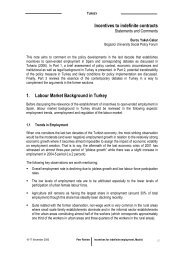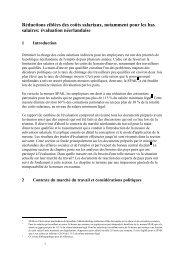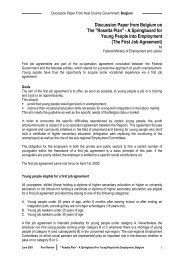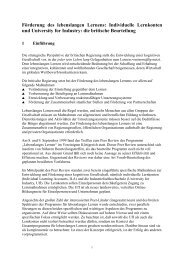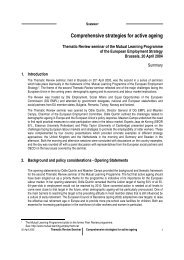Reform of Severance Pay Law in Austria - mutual learning programme
Reform of Severance Pay Law in Austria - mutual learning programme
Reform of Severance Pay Law in Austria - mutual learning programme
You also want an ePaper? Increase the reach of your titles
YUMPU automatically turns print PDFs into web optimized ePapers that Google loves.
DISCUSSION PAPER<br />
Koman et al. claim that the severance pay law reform is only a first step toward the expansion <strong>of</strong><br />
the underdeveloped second pension pillar <strong>in</strong> <strong>Austria</strong>. It replaces the former def<strong>in</strong>ed-benefit, f<strong>in</strong>alsalary<br />
severance payments scheme by a contribution-def<strong>in</strong>ed, fully funded system. The<br />
contribution rate <strong>of</strong> 1.53 percent is, however, too low to generate a significant second pillar<br />
retirement <strong>in</strong>come that could help to ma<strong>in</strong>ta<strong>in</strong> current replacement rates. Based on retirement<br />
<strong>in</strong>come projections and simulations <strong>of</strong> the pension reform for the blue and white collar workers’<br />
pension system, Koman et al concluded that an <strong>in</strong>crease <strong>of</strong> the contribution rate up to 5 percent<br />
could already be a major step toward a sufficient second pillar retirement <strong>in</strong>come.<br />
3.4 Fairness <strong>of</strong> the new system<br />
One explicit aim <strong>of</strong> the <strong>Austria</strong>n reform was to create more fairness <strong>in</strong> the distribution <strong>of</strong><br />
severance payments among employees. In order to evaluate the distributional effects <strong>of</strong> the<br />
<strong>Austria</strong>n reform Koman et al. (2005) performed an empirical analysis on a cross section <strong>of</strong><br />
completed job spells <strong>of</strong> different durations for which they compared severance pay <strong>in</strong> the two<br />
schemes. Koman et al. had to make two crucial assumptions. First, they do not observe complete<br />
<strong>in</strong>dividual employment careers and hence cannot say anyth<strong>in</strong>g about the accumulation <strong>of</strong><br />
severance payments dur<strong>in</strong>g the work<strong>in</strong>g life. Second, they assumed no voluntary quits as no<br />
<strong>in</strong>formation on the cause end<strong>in</strong>g the employment spell are available <strong>in</strong> the data.<br />
Accord<strong>in</strong>g to the simulations severance payments will be 35 per cent lower <strong>in</strong> the new system<br />
compared to the former scheme <strong>in</strong> the sample mean. Due to the more pronounced effects <strong>of</strong> the<br />
new scheme those <strong>in</strong>dividuals who were disadvantaged <strong>in</strong> the former scheme will be even more<br />
so <strong>in</strong> the new. Mean payment accord<strong>in</strong>g to both schemes differs mostly for women, young, and<br />
blue-collar workers. Note that the simulations did not consider accumulation effects dur<strong>in</strong>g<br />
work<strong>in</strong>g life.<br />
Overall, there are clear h<strong>in</strong>ts that the level <strong>of</strong> severance payments <strong>in</strong> the new system will be lower<br />
as <strong>in</strong> the former system. This is <strong>of</strong> course only true for workers, who did receive severance<br />
payments accord<strong>in</strong>g to the former legislation. The reform unquestionably extends the number <strong>of</strong><br />
workers entitled for severance pay considerably.<br />
4. Conclusions<br />
The reform <strong>of</strong> severance pay <strong>in</strong> <strong>Austria</strong> has attracted <strong>in</strong>ternational attention (e.g. OECD 2006,<br />
European Commission 2006). In the new system employers are required to contribute 1.53 % <strong>of</strong><br />
the gross wage to each workers <strong>in</strong>dividual account. This account is managed by the MVK’s,<br />
<strong>in</strong>vest<strong>in</strong>g the balance <strong>in</strong> the private capital market. In the event <strong>of</strong> dismissal, an employee with at<br />
least three years <strong>of</strong> job tenure has the option to receive severance payment <strong>in</strong> cash. Alternatively,<br />
the worker can leave the accumulated balance <strong>in</strong> the account, which is than carried over to the<br />
next job. The latter rule applies for dismissals dur<strong>in</strong>g the first three years <strong>of</strong> job tenure and for<br />
voluntary quits.<br />
Up to now around 2m employees have acquired entitlements <strong>in</strong> the new severance pay system.<br />
This system provides advantages for employers and employees. For employers liquidity problems<br />
due to simultaneous severance payments are prevented and there is no uncerta<strong>in</strong>ty related to the<br />
costs <strong>of</strong> severance pay at the time <strong>of</strong> hir<strong>in</strong>g. For the workers, job mobility costs are reduced<br />
30 Nov - 1 Dec 2006 Peer Review <strong>Reform</strong> <strong>of</strong> <strong>Severance</strong> <strong>Pay</strong> <strong>Law</strong>, Vienna<br />
17



